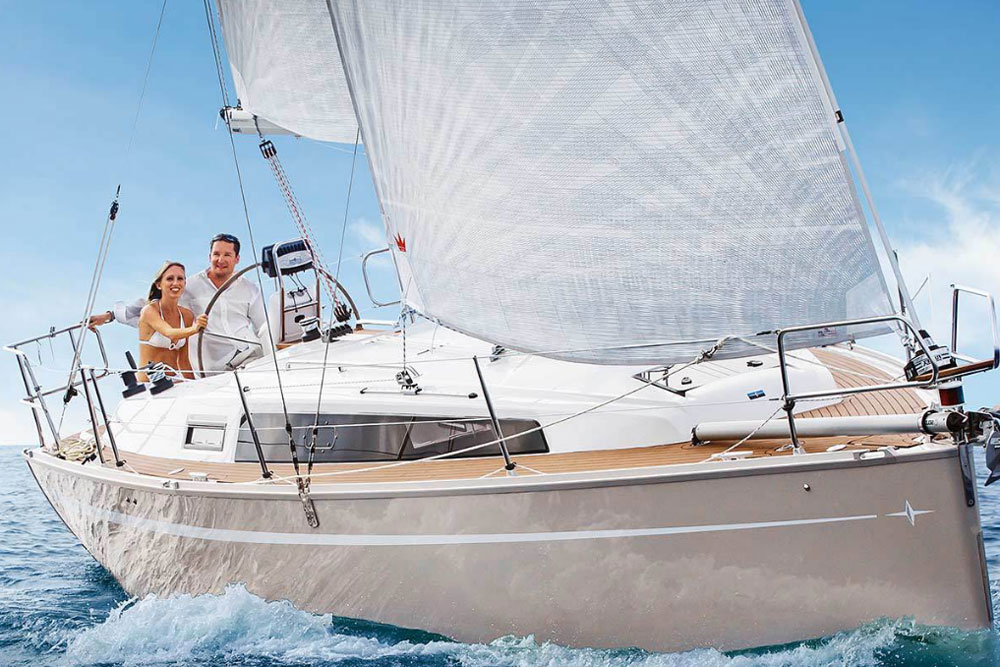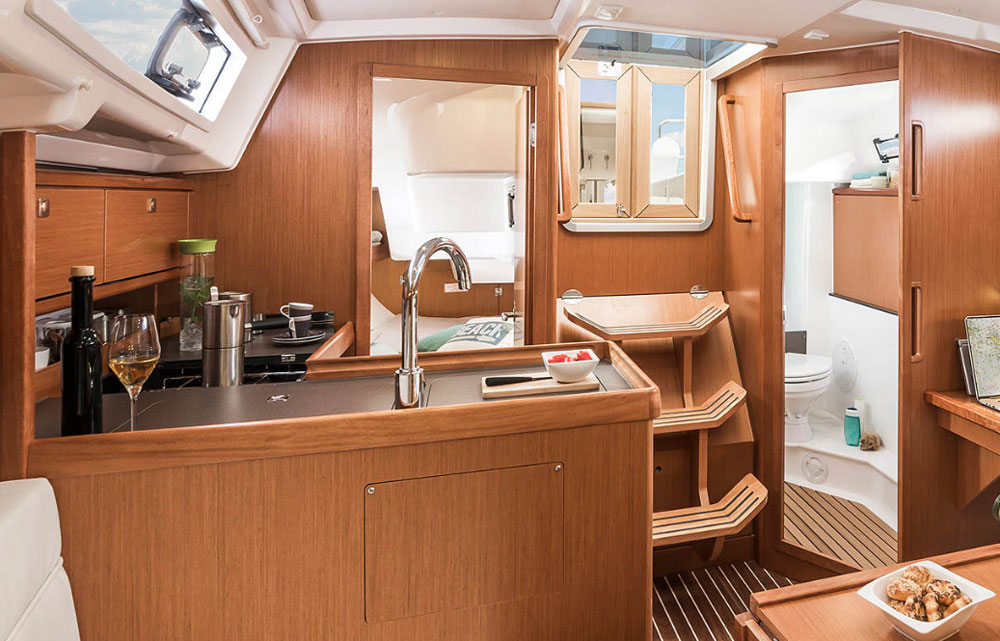Bavaria Cruiser 34 Review
This pocket cruiser has room for all the sailors in the family.
It’s easy to build a big sailboat that’s comfortable and sails fast. Lots of interior space, large swaths of deck, and a generous sail area are at the designer’s disposal. But the true magic of good design is creating a small cruiser that offers the amenities and sailing characteristics of a big boat—but fits a smaller slip and a tighter budget. Leave it to German engineering to build a vessel with an LOA of 32’ 9” that packs in up to three cabins, has a functional cockpit with one or two helms, and can sail at seven-plus knots on a waterline of only 30'.

The Bavaria Cruiser 34 replaces the previous Cruiser 33 and has a foam core sandwich hull and deck created with an infused construction, which brings her displacement in at under 12,000 pounds.
This boat is the first in the company’s line to be infused, and other models are set to follow. The Farr design feels a bit smaller than her advertised 34 feet and that’s because on deck, she’s only 32 feet. That makes her one of the smallest boats with three-cabin accommodations below. It’s a design feat to be sure but it does pack a lot into a small space and asks a compact model to do triple duty. This approach is popular in Europe, and American families with kids may rejoice, but to my eye two cabins will be plenty for most couples and their occasional guests.
Cruising Accommodations
With two cabins, the starboard aft stateroom is larger as is the head on the port side, although there’s no separate shower stall. This version of the model gains a small aft-facing nav station that shares the seat with the portside settee and garage stowage, accessible from the cockpit. The galley, saloon and forward stateroom remain the same in both layouts. Two hatches over the drop-leaf table in the saloon bring in lots of light and with the door to the master open, the boat feels a bit larger and airier inside.
The L-shaped galley is compact with a single sink, a two-burner stove, an oven and a top-loading refrigerator. There’s not a lot of space but it’s enough for a clever cook to turn out creative meals over the course of a long weekend.
Quality details include dovetailed joinery, solid wood doorframes and counter fiddles, a choice of wood finishes and integrated hatch and portlight shades. One striking thing is the lack of creaking. All the surfaces, including the cabin sole, felt solid and remained quiet as I moved about.

AGM batteries with a 276 Ah capacity and LED lighting will make evenings spent in the cabin comfortable.
On Deck
Topsides, the model is quite comfortable and well laid out. Our test boat had twin helms with a walkthrough from the companionway to the transom, which drops down to create a swim platform. This system is manual but the platform is so well counter-levered that I could lift it easily, almost with one hand. Teak decking is standard on the cockpit sole and benches as well as on the swim platform. It breaks up the bright white fiberglass surfaces and adds a bit of luxury to the overall look.
Carbon wheels (with Jefa steering) are optional, as are electronics by Garmin that include their 721 (seven-inch) touchscreen multifunction display with WiFi. The MFD is mounted at the aft end of the cockpit table and wind instruments and autopilot are at the starboard wheel. A Garmin VHF 300i AIS is also available and having AIS situational awareness equipment on a boat of this size is a nod to safety.
The single compass is mounted on a folding table that has interior stowage, integrated cup holders, and a plug for a light. In the single helm version, a large wheel is mounted on a pedestal that holds the MFD, instruments and compass, and butts up to the aft end of the cockpit table.
The sail plan is relatively simple with a traditional mainsail, lazy jacks and a bag. In-mast furling is optional as are tri-radial sails. The small jib tracks are on the cabin-top for tighter sheeting angles while the shrouds are all the way outboard and make moving about on deck easier. The double-spreader Selden rig is deck-stepped and comes with a rigid boomvang, so there’s no need for a topping lift.
The lifelines are very low–just tall enough to trip a tall sailor. However, in the plus column, the side gates are nice and wide so you can load coolers and other provisions from the dock with ease. Forward, an electric horizontal windlass with a remote control is tucked in a locker behind the roller furler. One thing Bavaria does very well is provide plentiful grab rails on all their models, so it’s always easy to find something to hold onto in the cockpit or below.
Cockpit stowage is limited to two small lockers aft, except in the two-cabin version where the portside bench opens to reveal a deep lazarett. A note on cost-effective bundling: Bavaria offers packages that combine popular options both inside and out and are an easy way to spec what you want without paying a la carte.
Out for a Sail
Our test day was blustery, so we stayed on a protected part of Biscayne Bay where 23-knot gusts came at us with calculated precision. Even with a reef in the fully-battened traditional mainsail, the little boat turned out to be a handful to sail with just two of us. There’s no traveler but adding one would help with fine-tuning the mainsail trim. That way, one crewmember could tend to it and the mainsheet as well as the working jibsheet, while the driver lets go the lazy sheet.
The spirited conditions in Miami showed that the 34, with her 549 square feet of upwind sail area, really likes to put her shoulder down and cut through chop like the Bavaria Cruiser 37 or the Cruiser 41, the 34’s larger siblings. In 18-20 knots of true wind, we sailed at 6.6 knots at 45 degrees apparent wind angle. As we eased off to 60 degrees, the boat sped up to 7.3 knots. In the gusts we were on our ear and busy just staying upright and holding on. For this reason, the standard 6’ 8” keel would be my preference over the optional 5’ 2” version—but that may hamper crusing in the shallow waters of the East Coast. As we turned downwind, everything smoothed out and we came up on our feet, still reeling off 6.2 knots at 150 degrees.
The Bavaria Cruiser 34 is just as spry with the sails down and motoring with her Volvo Penta 20 HP diesel and three-bladed folding propeller. (An upgrade to 30 HP is available.) At wide-open-throttle, we reached 7.3 knots at 3050 rpm but a nice cruising speed is at 2500 rpm and 6.2 knots. Tankage is 40 gallons each for both fuel and water. That amount of diesel will give the Cruiser 34 a range under power in excess of 400 miles with a reserve.
A larger boat may offer more elbow room and a heavier ballast to ride out the gusts, but it doesn’t necessarily add fun or functionality to a boating weekend. That’s where the small Bavaria Cruiser 34 shines. She’s a tidy package with enough stowage space, sleeping accommodations, and galley amenities for cruising, yet she’ll still be comfortable in a 33-foot slip. She also moves well in a breeze and with a base price tag of $120,000 ($141,000 as tested), won’t cause sticker shock either.
Other Choices: The Beneteau Oceanis 35 will be of interest to those looking at the Cruiser 34. Another to check out is the Hanse 315. Those who want a more performance-oriented racer/cruiser should look at the Salona 33.
For more information, visit Bavaria.
See Bavaria 34 Cruiser listings.
| Specifications | |
|---|---|
| Length | 32'9" |
| Beam | 11'3" |
| Draft (shoal/deep) | 5'2"/6'8'' |
| Sail area | 549 sq. ft. |
| Displacement | 11,684 lbs |
| Fuel capacity | 40 gal. |
| Water capacity | 40 gal. |

















